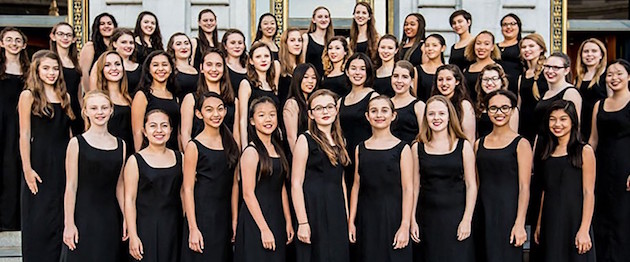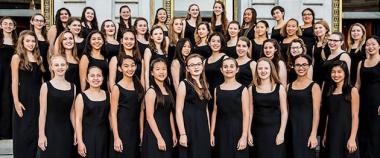
The transition from winter to spring coincides in the Christian liturgical calendar with the season of Lent, which starts this week and leads up to Easter Sunday.
In celebration of this time of introspection and contemplation, the San Francisco Girls Chorus (SFGC) performed a series of psalm settings by mostly 19th-century composers in a program called “Out of Darkness,” last weekend in San Francisco and Oakland; guest organist Paul Vasile accompanied, and Music Director Valérie Sainte-Agathe conducted.
Positioned around the audience in the front pews of the church, the members of the Girls Chorus opened the performance at San Francisco’s Mission Dolores Basilica on Saturday night a cappella with the only 21st-century work on the program, “Peace upon you, Jerusalem” (2002), by Estonian composer Arvo Pärt (b. 1935).
To find yourself enveloped in the wonderful voices of the Girls Chorus and to hear Pärt’s spellbinding music as it expands and contracts, moves through the space, rushes forward, and comes to a standstill on one note, is a remarkable, spine-tingling experience.
Great art can seem effortless, but it is obvious that the young women of the SFGC possess great musical and stage discipline and work hard to reach their praiseworthy level of effortlessness, which is even more impressive since most of the repertoire of “Out of Darkness” was intended for mature women’s voices, and requires performers who can dip into a full range of emotion and expression.
And the young female singers of the SFGC, way past the “girl” stage, delivered beautifully.
Organist Paul Vasile accompanied the SFGC in works by Francis Poulenc (1899-1963), Johannes Brahms (1833-1897), and Felix Mendelssohn (1809-1847) and gave a solo performance of the rarely heard Psalm Prelude, Op. 32, No. 1. by English composer Herbert Howells (1892-1983).
His role was different in every one of these works. In Poulenc’s Litanies à la Vierge Noire (Litanies to the black Virgin), the organ is an equal partner to the chorus, setting the tone for the singers; emphasizing the drama in the litany; painting the mood around phrases like ‘holy mysteries’; or intensifying the desperate pleas for mercy to the Virgin Mary, while in Brahms’ setting of Psalm 13, Op. 27, and in Mendelssohn’s Three Motets, Op. 39, the organ has a more traditionally accompanying part.
Howells’ ‘Psalm Prelude’ is based on the verse ‘This poor man cried, and the Lord heard him, and saved him out of all his troubles’ (psalm 34:6) and the composer consequently exploits the full range of the organ, from the quietest whispers to the loudest roar. The Prelude starts in near-silence, builds up to a climactic outcry, and then retreats back into silence.
Under Vasile’s hands the Prelude sounded articulated, transparent, and powerful within the limits of the digital organ console of the Basilica, but I am sure that Sunday’s performance, on the large pipe organ of the First Presbyterian Church of Oakland was an entirely different sensory experience.
One of the absolute high points of the concert was the hymn Ave Maris Stella by Edvard Grieg (1843-1907). Sung a cappella by thirteen members of the Girl Chorus, sans direction from Sainte-Agathe, I was struck by the simple beauty of the piece and the musical grace and elegance of the singers.
“Out of Darkness” culminated in Mendelssohn’s Three Motets, a melodic mini-cantata that flows through a wide range of emotions, but ends in a jubilant “Surrexit Christus spes mea” (The Risen Christ is my hope) and a cheerful “Alleluja.”

